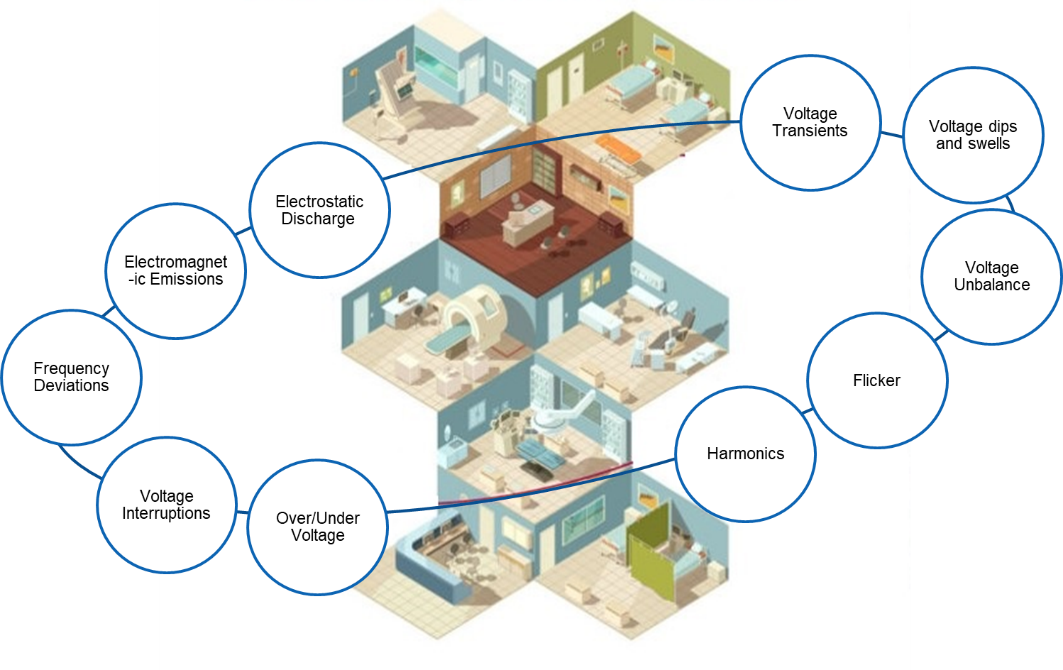Power Systems in hospital facilities are particularly vulnerable given the sudden increase in nonlinear electronic loads comprising of ventilators, diagnostic imaging equipment, Patient monitors and many bio medical devices – a crucial defense aid in fighting COVID. With improper electrical systems, further marred by non-compliance to electrical standards and poor workmanship, hospitals are staring at the high risk of overheating their electrical installation that could provoke fire.
Fire Causes:
Faulty electrical outlets and old, outdated equipment are the leading causes of electrical fires.Never use a device with a broken or damaged cable because it can cause a fire by sending heat to flammable surfaces including floors, drapes, and carpets.
Fire prevention:
Around a socket, light switch, or light fixture, there may be burn marks or discoloration. When you touch an appliance, an outlet, or a power wire, it feels warm. When an object is plugged in or in operation, it emits a burning odor. When you plug in a gadget, electrical sparks appear. Each time you plug in a gadget, you get an electric jolt.
REASON:Electrical fires causes and prevention
Poor electrical wiring and cabling
Power-hungry electrical equipment such as MRI, CT Scans, and X-Ray machines, Ventilators and other medical devices, used in hospitals need uninterrupted power supply. A durable cable network is thus absolutely essential to carry this power supply without overheating.
Faulty electrical installations in an oxygen-rich environment
Areas such as operation theaters and ICUs have a high concentration of oxygen. Any electrical short circuit in these areas, could lead to electrical shock to surgeons or patients. In order to achieve uninterrupted power, or for surge control, UPS systems are used which are supported by batteries.
Use of batteries
Increased use of flammable alcohol-based sanitizers
With the addition of Ventilators, air-conditioners, high-capacity machines in the ICUs, testing facilities for COVID, the addition of more rooms, and increased use of flammable alcohol-based sanitizers or PPE kits, risks of fire are only going higher. Add to it the poorly designed power systems built with even poorer workmanship, it all works like oxygen to start an electrical fire and feed it further.
SOLUTION- BUILDING A PROACTIVE APPROACH TO FIRE SAFETY
Ensure compliance to building codes for safety and reliability
Fire in Covid-19 Hospitals - Prevention must be the goal Hospitals that use several non-linear loads and sensitive electronics alongside heavy-duty air conditioners and heaters, other large or small medical testing instruments, and are therefore always at the risk of poor power quality. While the first responsibility to ensure compliance to building codes for safety and reliability rests with designers.
Electrical & Fire Safety Audit
Proper maintenance and monitoring of Power Quality on an ongoing basis is important. With rising number of electrical fires in hospitals, several state and regulatory agencies have ordered a fire audit of the facilities. While a proactive fire audit of the COVID hospitals is a welcome move, the fire audits are testing the ability of the facility to protect itself from the fire, if it were to occur, not prevent the fire.
Wire your electrical networks right
Poor quality cables could lead to a serious fire incident at a hospital. It is vital that attention be paid to the wiring in the entire health facility. The global norm is to use ‘Low Smoke and Zero Halogen (LSOH) wiring. However, in India, Flame Retardant Low Smoke (FRLS) wires are used widely. Reports suggest that these wires may not necessarily help avoid fire incidents completely.
The ventilation system
The ventilation system in a hospital also has a role to play in this scenario. If the hospital is air-conditioned, an efficient mechanical ventilation system must be installed to avoid electrical fires from spreading
Pay attention to earthing
A common practice in the Indian setup is to use separate earthing connections for all the electronic medical or non-medical equipment, but it is unjustified.
All conductive metal in an equipotential area should be connected to a common equipotential earthing point with a special heavy-duty cable. This reduces the possibility of leakage currents that can cause micro electrocution when the surgeon or patient comes into contact with the equipment.Ensuring good Power Quality to prevent electrical fire
There are several tools to proactively identify the vulnerabilities in power systems, including power quality issues, much before they lead to extreme events of electrical fire.
Thermal Imaging is highly helpful in understanding the potential overheating in the electrical network. Periodic measurements and monitoring of harmonic distortion helps in early identification and prevention of heating in the electrical cables.
Isolation Transformers for sensitive imaging devices or diagnostic equipment
Passive/Active harmonic Filters help to minimize the electrical fire risks emanating in infrastructure having Biomedical, IT/ ITeS, Building automation with non-linear electronic loads, Capacitor banks, UPS Batteries etc.
For more information, contact us at [email protected]"



